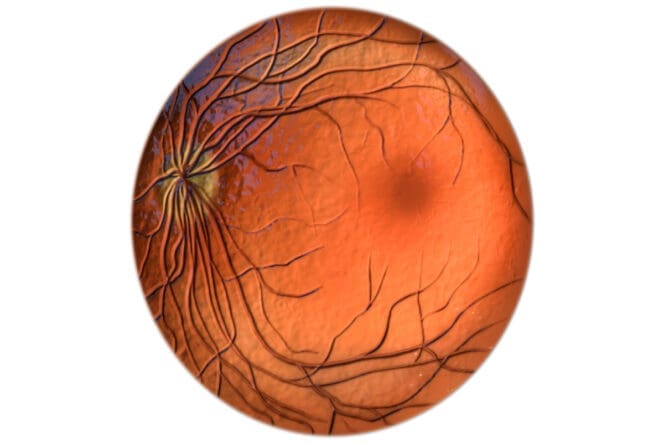Home / Eye Health /
Optic Nerve Cupping: Causes, Reversal, and Treatment
Optic nerve cupping is also known as optic disc cupping. The “cupping” that doctors see stems from the death of smaller nerves around the optic nerve, creating a cup visual. The loss of the nerves concerns doctors because it could lead to loss of the primary nerve, which can lead to partial or total blindness.
What Is Optic Nerve Cupping?
Optic nerve cupping is a serious eye condition that requires immediate treatment, regardless of the stage of its development. The eyes connect to the brain via optic nerves. These nerves are about 3mm thick, and each contains over a million nerve cells.
Glaucoma damages these nerve cells, resulting in blind spots. This visual condition is caused by an increase in pressure in the eye, which can lead to damaged optic nerves. Consequently, damaged optic nerves lead to the loss of individual nerve cells.
When there’s a substantial loss of nerve cells, the size of the optic disc grows, leading to optic nerve cupping.

What Causes Optic Disc Cupping?
Optic nerve cupping is categorized into two major groups. The first is caused by injury or trauma, while the second is the result of various medical conditions or diseases. Some of the medical conditions that may lead to optic nerve cupping include:
- Glaucoma
- Optic neuritis
- Optic nerve atrophy
- Optic nerve head drusen
Glaucoma
Glaucoma is the leading cause of blindness. It develops when the fluid pressure in the eyes gradually rises, which in turn damages the optic nerves. Apart from deteriorating vision, other common warning signs of the condition include headaches, severe eye pain, redness and nausea.
Optic Neuritis
Optic neuritis is the swelling or inflammation of the optic nerves. The condition can develop in isolation or as a result of an underlying condition. Some of the related causes and diseases that contribute to the condition include multiple sclerosis, immune-related diseases, and various medications.
The symptoms present in optic neuritis cases can vary widely depending on the underlying factors. Common signs of the condition include vision loss in one eye, periocular pain, and Uhthoff’s phenomenon.
Optic Nerve Atrophy
This is the gradual deterioration of the optic nerve and can be the result of insufficient blood flow to the eyes, tumor, hemorrhage, inflammation, degenerative conditions, or exposure to toxic substances. Signs of optic nerve atrophy may include blurred vision, color vision sensitivity, and changes in the optic disc.
Optic Nerve Head Drusen
These are calcium and protein salts that gradually build up in the optic nerve. While the condition is usually asymptomatic, some early warning signs include blind spots and dimmed vision.
Symptoms of Optic Nerve Cupping
The symptoms of optic disc cupping could vary significantly, depending on the underlying cause. Some of the above-mentioned warning signs to different causes and contributing factors may affect the symptoms you experience. The most commonly observed symptoms of optic disc cupping include:
- Reduced sharpness in your vision
- Difficulties with peripheral vision
- Blurred vision
- Difficulties with color vision and sharpness
How Is Optic Disc Cupping Diagnosed?
The optic nerve is small and cannot be detected by the naked eye. If you experience any of the symptoms or conditions mentioned above, you should seek professional care services.
Optometrists and ophthalmologists can diagnose the condition with an ophthalmoscopy test. This test monitors the ratio of the cup to the disk through periodic photographs. This helps the doctors analyze the progression of the damage and effective remedial procedures.
How Is Optic Nerve Cupping Treated?
There are no available remedies to reverse the effects of cupping and restore your sight. But depending on the causes and underlying factors, various treatments can be used to prevent further progression of the conditions. Treatments include:
- Eye drops, oral medication and surgical procedures like laser therapy for patients diagnosed with glaucoma.
- Intraocular pressure-lowering medication for patients suffering from optic nerve drusen.
- Prescription steroids for patients dealing with optic neuritis, which stop the condition from worsening.
For patients with optic nerve atrophy, there are no proven medications or treatments that can reverse the damage. Doctors can advise on precautions and treatments to reduce inflammation.
Can Cupping Occur Without Glaucoma?
By itself, cupping is not visible to the naked eye, nor does it cause cosmetic damage. Doctors may not rush to treat cupping if there are no other warning signs. However, it is right to mention that cupping can increase your chance of developing glaucoma, so regular tests are needed to monitor your visual health.
FAQs
Can optic nerve cupping be reversed?
When the condition is identified in the early stages of primary congenital glaucoma, the optic nerve cupping is reversible. This is done following the successful reduction of IOP.
Can optic nerve cupping be treated?
While the treatment options are limited when identified early and with proper care, you stand an increased chance of treatment success. The standard optic disc cupping treatment typically starts with medical therapy followed by laser trabeculoplasty and filtration surgery when necessary.
References
-
What Is Glaucoma? Symptoms, Causes, Diagnosis, Treatment. (September 22, 2021). American Academy of Ophthalmology.
-
Don’t Let Glaucoma Steal Your Sight. (November 24, 2020). Centers for Disease Control and Prevention.
-
Association Between Metabolic Risk Factors and Optic Disc Cupping Identified by Deep Learning Method. (September 17, 2020). Public Library of Science.
-
Reversal of Optic Disc Cuing in Glaucoma. (August 10, 2019). British Journal of Ophthalmology.
-
Uhthoff`s Phenomenon 125 Years Later – What Do We Know Today? (March 9, 2016). National Center for Biotechnology Information.
-
Clinical Methods: The History, Physical, and Laboratory Examinations. 3rd edition. (June 18, 2011). National Center for Biotechnology Information.
-
How Does The Eye Work? (May 28, 2009). National Center for Biotechnology Information.
Last Updated July 1, 2022
Note: This page should not serve as a substitute for professional medical advice from a doctor or specialist. Please review our about page for more information.